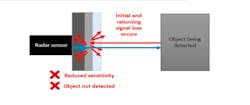Opinion: Refinish industry standard is needed to maintain self-driving vehicle safety
Content brought to you by ABRN. To subscribe, click here.
What you will learn:
- The critical role coatings play in the functioning of ADAS.
- Nearly two-thirds of new cars and light trucks have at least one type of ADAS, which is expected to rise to 85 percent by 2025
- There can be a loss in the transmission of radar signals through painted panels
Safety is a hot issue for the latest generation of “self-driving” vehicles, particularly those that use advanced driver assistance systems (ADAS). This follows a spate of incidents where self-driving vehicles crashed while being tested when the ADAS technology failed to detect an obstacle.
But it’s not just an issue for future vehicles. Already, nearly two-thirds of new cars and light trucks have at least one type of ADAS, which is expected to rise to 85 percent by 2025, according to a study by consulting firm Roland Berger. ADAS systems are used to provide things like adaptive/traffic-aware aware cruise control, parking assistance, lane departure warning/correction, traffic signal recognition, rear collision warning, cross-traffic warning, emergency braking, and collision avoidance.
ADAS works by detecting objects and road markings using radar (based on radio waves), ultrasound, and cameras. Auto manufacturers are also working on a new generation of ADAS based on lidar, which uses infrared light.
What you probably don’t know is the critical role that coatings play in the functioning of ADAS. Radar equipment is usually located behind the painted surface of the vehicle, and there may be an interaction between the equipment, the body panel (metal or plastic), and the coatings, which can affect the performance or accuracy of the ADAS.
There can be a loss in the transmission of radar signals through painted panels. If this exceeds a certain amount of loss, it may not function as designed. This loss is particularly associated with certain metallic paints – these typically contain particles of aluminum, which can dampen the signals and may lead to a loss in the sensitivity of ADAS.
That’s why automotive paint companies are investing resources to understand and develop radar-capable coating and the proper repair process to ensure the integrity of ADAS systems.
However, there is currently no industry standard to define an acceptable signal loss. This makes it difficult for both makers of refinish coatings and collision repair shops to ensure that they provide the right coatings.
A related issue exists for the lidar systems currently under development. Darker colors absorb more infrared light than lighter colors, which means it is more difficult for dark objects to be detected. In one test, a black car reflected just six percent of the lidar signal that a white car did, making it dramatically less “visible” on the road.
PPG is working to address those concerns by developing coatings that allow the signals to penetrate through the color coat down toward a reflective under layer. The signal “bounces off” this layer and returns to the lidar system instead of being absorbed.
The company has technology in the pipeline to make black more reflective by venturing beyond the visible color spectrum using near-infrared pigment technology. The coating leverages commercially proven technology from PPG’s aerospace business—the same technology can also be used for infrastructure such as bridges to make them more visible to a car’s sensors.
As we move toward increased vehicle autonomy, there is a critical need for a global industry standard when damaged vehicles are repaired to make sure their ADAS systems operate correctly. PPG is calling on all stakeholders, auto manufacturers, paint makers, the collision repair industry, and regulators to agree on a set of standards to make sure vehicles are safe, as well as smart.
About the Author

Nick Tullett
With 36 years of industry experience, Nick Tullett serves as a global products and segments director in PPG's automotive refinish business. At PPG, we work every day to develop and deliver the paints, coatings and materials that our customers have trusted for nearly 140 years. Through dedication and creativity, we solve our customers' biggest challenges, collaborating closely to find the right path forward. PPG's automotive refinish business is singularly focused on delivering state-of-the-art technology to meet the needs of collision repair centers. With headquarters in Pittsburgh, Pennsylvania, we operate and innovate in more than 75 countries. To learn more, visit www.ppgrefinish.com
